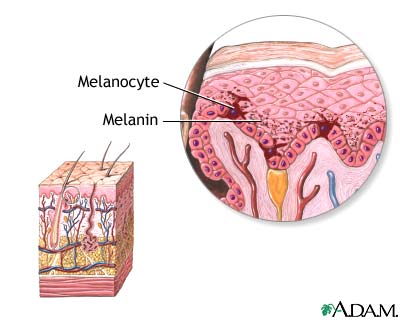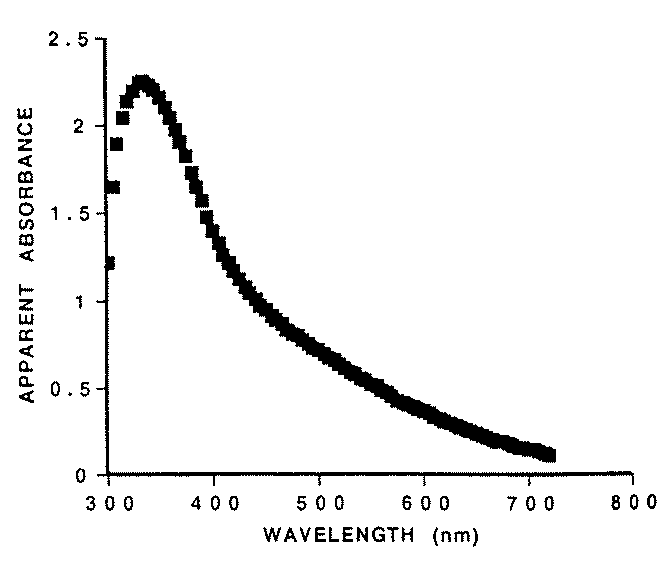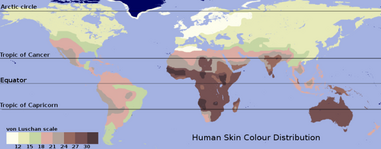Vitamin D and Human Skin Color
Melanin
Human skin color is primarily determined by the content of melanin in
the skin. Melanin is found in the skin, hair, and iris, giving
humans their coloration. Melanin is present in other areas of the
human body as well, but these are the most easily observed (21).
Melanin in the skin is produced by melanocytes. These are found
in the stratum basale of the epidermis, which is the lowest layer of
the dermis. Most humans have a similar concentration of
melanocytes within their skin; however, expression of melanin-producing
genes varies greatly within individuals and ethnicities. Humans
who produce no melanin have a condition called albinism (21).

Melanin Location Within the Skin (
http://www.besthealth.com/besthealth/bodyguide/reftext/images/Melanin.jpg)
The two main types of melanin found in human skin and hair are
pheomelanin and eumelanin, with eumelanin being the most
abundant. Pheomelanin provides a red tone, while eumelanin lends
a dark brown to black color (2, 12, 21, 23).
Melanin is essentially a natural sunscreen found within the skin.
It absorbs UV B light, the same light that initiates the production of
vitamin D3. Because the light gets absorbed by the melanin, it
actually requires a longer exposure time for people with a higher
concentration of melanin in their skin to manufacture vitamin D3.
For example, in one experiment, a light-skinned person experienced a
50-fold increase in blood concentrations of vitamin D3 within 8 hours,
whereas a dark skin person exposed to the same dose did not exhibit any
changes in the blood concentrations of vitamin D3. In fact, the
darker skinned person required 5-10 times the exposure than the light
skinned person, and still only had a 30-fold increase in their blood
concentrations. (sunlight and vitamin D for health) Thus,
the additional melanin which causes the darker skin can also be blamed
for vitamin D deficiency (1, 2, 5, 11, 12) .

Melanin Absorbance Closely Matches that of 7-dehydrocholesterol
(
http://www.cl.cam.ac.uk/~jgd1000/melanin.html)
Melanin also protects against skin cancers. The melanin absorbs
not only UV-B radiation, but also UV-A. Light skinned people have
approximately a 10 times greater risk of dying from skin cancer than
darker skinned people when exposed to the same sun conditions (5).
Evolution
Human skin can vary from an extremely light pigmentation (no color at
all is a genetic mutation called albinism) to a very dark brown.
The color is dictated by the amount of melanin in the skin.
However, the question of what caused this skin tone variation was a
puzzle for quite some time. The production of vitamin D in
relation to the amount and quality of sunlight received is part of the
answer to this puzzle (1, 2, 11, 12, 17, 18, 21, 23).
It has been stated that the default human skin color is most closely
related to that of Ethiopians (a light brown shade). However, as
stated above, there is a large variation in colors. Obviously,
there is a factor that alters the default situation to other
tones. Essentially, there is an adaptation that causes a lighter
skin color and an adaptation that creates a darker skin color than the
default (17, 18).
The darker adaptation seems to come from a need for folate. If
there is not enough melanin in the skin at lower latitudes (near the
equator), too much UV radiation is able to penetrate the skin.
The intense UV causes a halt to the folic acid synthesis - the result
of the lack of folate can cause neural tube defects in unborn
fetuses. A higher level of melanin allows normal folate synthesis
by absorbing the UV radiation, and can allow for normal gestation and
fetal development. Essentially, evolution allowed for a feature
(darker skin) that would allow healthy and successful reproduction.
The lighter adaptation allows for a greater quantity of vitamin D
synthesis. A greater amount of epidermal melanin blocks UV
penetration which is needed for the transformation of
7-dehydrocholesterol to calciferol (vitamin D3). Vitamin D
deficiency can result in multiple issues such as rickets and other
skeletal deformations. This was primarily discovered as it became
evident that darker skinned people who moved to higher latitudes began
to suffer from vitamin D deficiencies, while lighter skinned people at
the same latitudes had no such issues.
Therefore, human skin color evolved via natural selection for each
latitude to block enough UV to allow for folate synthesis, yet allow
enough UV to penetrate the skin to allow for sufficient vitamin D
production (1, 2, 11, 12, 17, 18, 21, 23).

http://www.biocrawler.com/encyclopedia/Human_skin_color
This picture demonstrates the skin color that should occur at various
latitudes due to the concentration of melanin necessary to both prevent
folate destruction and promote adequate vitamin D synthesis.


